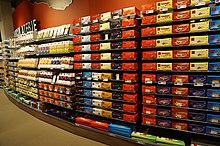Chocolat Frey
After his training as a commercial employee with the company S.A. de la Fabrique des Chocolats Amédée Kohler et fils in Lausanne, Robert dealt with machines for the manufacture of chocolate in the engineering works Riccard & Greiss in Paris.
Max completed his commercial apprenticeship with the company Cramer-Frey in Zurich, for which he was eventually also active in Brazil.
[8] The invention of milk chocolate by Daniel Peter in 1875, allowing the use of more local resources, also favored the establishment of Frey.
The importance of cocoa was diminished with the use of less expensive ingredients such as milk, nuts and dried fruits.
Germany and France were too preoccupied with the reconstruction and were no longer trading partners, leaving only England.
During these years Robert Frey junior (born February 18, 1901) gradually took over the company management.
New import regulations for cocoa and sugar limited the Swiss chocolate market a great deal.
Furthermore, many employees as well as executives were called up for military service, so that the company lacked sufficient personnel to advance.
Although the chocolate factory had to adopt the new owner's terms and conditions, the company management remained in the hands of Robert Frey junior.
[8] In 1963 the construction of the present headquarters began and the plant was relocated from Aarau to Buchs in the Canton of Aargau.
At the same time the entire chocolate, confectionery and sweets manufacture, which Migros had operated until then, was centralised in one location.
Since 1974, as the only Swiss manufacturer it has also produced chewing gum, which today accounts for around 10% of Frey's total annual turnover.
In 1985 the company's turnover exceeded the CHF 200 million threshold for the first time and the firm soon took over leadership on the domestic chocolate market.
The United Kingdom, the USA, Denmark, Austria and Japan, later also France and South East Asia, imported the chocolate of Frey.
Nonetheless, Delica AG will remain a corporate body, as do the two sites of Buchs and Birsfelden.
[15] Also in 2014, Frey acquired North American SweetWorks Confections and its manufacturing facilities in Buffalo and Toronto.
Prices were reduced and products from Lindt and Toblerone were added to the Migros range as of April 2021.
[20] In 1966 the manufacturing base of Frey relocated from Aarau to the newly built factory in Buchs in the Canton of Aargau.
Today it comprises several buildings on an area totalling around 70,000 m2, for storing and processing cocoa and manufacturing chocolate and chewing gum.
for further processing in industry and trade, chewing gum under the brands Skai and Candida as well as private labels.
Sustainable development can only be achieved by considering economic, social and ecological criteria in equal measure and along the entire value chain.
Thanks to the utilisation of district heating instead of crude oil, respective structural measures, raising awareness and training of personnel as well as consistent controlling, energy consumption could be decreased by almost a quarter over the past few years, thus lowering the emission of CO2 significantly.
In line with this, Frey was awarded ‘CO2-reduced company’ certification by the commercial environment agency for its voluntary endeavours in favour of climate protection.
In August 2019, Migros announced that the controversial additive would initially no longer be added to a large part of the range of its in-house chewing gum brand Skai.




